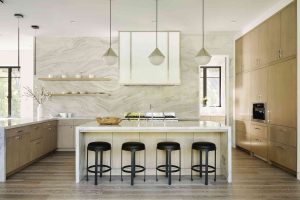Discover the Ultimate Guide to Modern Kitchen Styles

Importance of Kitchen Styles
When it comes to home design, the kitchen is often dubbed the heart of the home. It’s the space where families gather, meals are prepared, and memories are made. This importance naturally extends to the style and design of the kitchen. The aesthetic and functionality of kitchen styles are vital for several reasons:
- Discover the Ultimate Guide to Modern Kitchen Styles
- Importance of Kitchen Styles
- Evolution of Modern Kitchen Designs
- Minimalist Kitchen Style
- Characteristics of Minimalist Kitchens
- Tips for Achieving a Minimalist Look
- Industrial Kitchen Style
- Elements of Industrial Kitchens
- Incorporating Industrial Design in Your Kitchen
- Scandinavian Kitchen Style
- Features of Scandinavian Kitchens
- Creating a Cozy Scandinavian Vibe
- Farmhouse Kitchen Style
- Rustic Elements in Farmhouse Kitchens
- Mixing Vintage and Modern in Your Farmhouse Kitchen
- Influence on Mood: A well-designed kitchen can significantly uplift the spirit of the home. Bright, open layouts often create a welcoming atmosphere, while darker, more enclosed designs can feel cozy or even claustrophobic.
- Enhancing Productivity: Different kitchen styles promote efficiency in meal prep and organization. For example, a minimalist kitchen, with its clean lines and clutter-free surfaces, can foster a more focused cooking environment.
- Reflecting Personal Style: The kitchen is a canvas for homeowners to express their personalities through design choices. Whether someone favors warmth and rustic vibes or sleek, modern finishes, the style of a kitchen can say a lot about its owner.
As trends evolve, so too does the allure of various kitchen styles, making it essential to stay informed on what’s popular and functional.
Evolution of Modern Kitchen Designs
The evolution of kitchen designs has been nothing short of remarkable over the decades. In the past, kitchens were often hidden away from the main living areas, seen merely as functional spaces. Today, however, they have transformed into open-concept gathering areas that prioritize both style and utility. Consider this evolution:
- Mid-20th Century: Kitchens were designed with efficiency in mind, featuring appliance dominance and compact layouts. Individuality took a backseat as functionality reigned supreme.
- 1980s and 1990s: The introduction of elaborate cabinetry and bold colors changed the landscape. Homeowners began to prioritize aesthetics, leading to more tailored, themed spaces.
- 21st Century: In recent years, the focus has shifted towards sustainable materials and smart technology integration. Innovations like open-plan layouts and multifunctional islands have emerged, marrying style with practicality.
Ultimately, understanding the importance of kitchen styles and their evolution allows homeowners to make informed decisions that enhance their living spaces and align with their personal preferences. Whether one leans towards minimalist, industrial, Scandinavian, or farmhouse designs, the kitchen stands as a central message of home and lifestyle.
Minimalist Kitchen Style
Characteristics of Minimalist Kitchens
Having explored the significance and evolution of kitchen designs, let’s dive into one of the most sought-after styles: the minimalist kitchen. Minimalism is a breath of fresh air in the often chaotic world of home design. It emphasizes simplicity, functionality, and a clean aesthetic, allowing homeowners to enjoy a clutter-free environment. Key characteristics of minimalist kitchens include:
- Sleek Lines and Shapes: Minimalist kitchens prioritize clean lines and uncomplicated shapes. This means flat-panel cabinets, straightforward countertops, and streamlined appliances that blend seamlessly into the design.
- Neutral Color Palette: Expect whites, grays, and soft earth tones dominating the scene. These colors not only create a serene atmosphere but also serve as a perfect backdrop for statement items like unique light fixtures or artistic decor.
- Functional Space: Every element in a minimalist kitchen serves a purpose. Open shelving may replace bulky cabinets, allowing for easy access to essential items while showcasing beautiful dishware.
- Natural Light: Large windows are a hallmark of minimalist kitchens, welcoming natural light and creating an airy feel. Even smaller spaces can feel spacious when well-lit.
By embracing these characteristics, minimalist kitchens become sanctuaries of simplicity and functionality.
Tips for Achieving a Minimalist Look
Creating a minimalist kitchen might seem daunting, but with a few simple strategies, anyone can capture this elegantly understated design. Here are some practical tips to help achieve a minimalist look:
- Declutter: Begin by removing unnecessary items. Keep only what’s essential and consider storing infrequently used gadgets out of sight. A clean countertop is key in minimalist spaces.
- Choose Quality over Quantity: Invest in high-quality materials and appliances that offer durability and timelessness. Stainless steel appliances and solid wood cabinetry can be both functional and chic.
- Incorporate Smart Storage Solutions: Maximize space with innovative storage options like pull-out drawers and hidden cabinets. Consider vertical storage to keep surfaces clear while utilizing wall space effectively.
- Maintain Uniformity: Stick with a limited color palette and consistent finishes. For example, if you choose brass fixtures, maintain that finish throughout to create harmony.
- Add a Touch of Nature: Introduce plants or herbs for a pop of color and freshness without cluttering the space. They add life while complementing the clean aesthetic.
Incorporating these tips into kitchen design will help to achieve the minimalist look that promotes tranquility, functionality, and timeless beauty. As more people seek mindfulness in their homes, minimalist kitchens provide the perfect backdrop for a simplified lifestyle.
Industrial Kitchen Style
Elements of Industrial Kitchens
Having explored the calming aesthetics of minimalist kitchens, let’s shift gears to the bold and eclectic world of industrial kitchen design. Inspired by urban lofts and warehouses, this style embraces raw materials and utilitarian features, creating a chic yet rugged look that’s as functional as it is visually striking. Key elements of industrial kitchens include:
- Exposed Structures: One of the defining features of industrial kitchens is the visibility of architectural elements. Think exposed beams, ductwork, and brick walls. These raw attributes create an urban vibe that feels effortlessly stylish.
- Rugged Materials: Industrial design focuses on materials like reclaimed wood, stainless steel, and concrete. These materials not only enhance durability but also contribute to a textured, layered look that’s appealing and functional.
- Open Spaces: Industrial kitchens often favor open layouts that promote a sense of community and functionality. This openness allows for seamless interaction during meal prep and socializing.
- Edgy Color Palettes: Darker colors—especially shades of gray, black, and brown—are typical in industrial designs. Accents of metals or vibrant colors can add personality without overpowering the raw aesthetic.
These elements come together to create an inviting space where the kitchen feels both organized and creatively chaotic.
Incorporating Industrial Design in Your Kitchen
Integrating industrial design into your kitchen can be a rewarding project that instills character and style. Here are some practical tips to embrace this design:
- Install Open Shelving: Rather than traditional cabinets, opt for open shelves made from reclaimed wood or metal. This choice not only displays your dishware but also reinforces the industrial aesthetic.
- Choose Statement Lighting: Pendant lights with metal finishes will draw attention while adding functionality. Large, vintage-style bulbs or fixtures can evoke the industrial vibe, becoming focal points in your space.
- Use Vintage Accessories: Incorporate unique vintage finds like old crates, metal stools, or factory-inspired furniture. These elements add a sense of history and authenticity to your kitchen.
- Opt for Concrete or Metal Surfaces: Consider concrete countertops or stainless-steel islands. These materials are not only durable but also enhance the industrial look.
- Keep Things Bare: Avoid overcrowding your kitchen with decorative items. Instead, celebrate the beauty of open space with a few select decor pieces that contribute to the overall design narrative.
By embracing these elements and tips, homeowners can easily craft an industrial kitchen that balances functionality and style. This design speaks volumes, transforming a simple cooking area into a creative hub that resonates with the vibrant energy of city life.
Scandinavian Kitchen Style
Features of Scandinavian Kitchens
As we transition from the bold elements of industrial kitchens, let’s explore the warm and inviting realm of Scandinavian kitchen design. Characterized by its simplicity and functionality, this style is all about embracing light, natural materials, and effortless beauty. Key features of Scandinavian kitchens include:
- Bright and Airy Aesthetics: Scandinavian design often utilizes a light color palette, predominantly whites and soft pastels. This maximizes natural light and creates an inviting atmosphere.
- Natural Materials: Wood, especially light-toned varieties like pine and birch, plays a crucial role in Scandinavian kitchens. These materials add warmth and a connection to nature, making the space feel cozy.
- Functional Design: Every piece in a Scandinavian kitchen serves a purpose. From multi-functional furniture to clever storage solutions, functionality is at the core of this design philosophy.
- Minimalist Decor: Clutter-free surfaces are essential. Scandinavian kitchens embrace minimalism that highlights essential items—think simple vases, clean lines, and essential kitchen gadgets.
These features come together to create a serene and functional kitchen space that feels effortlessly stylish and welcoming.
Creating a Cozy Scandinavian Vibe
If you’re drawn to the inviting essence of Scandinavian kitchens, here are some practical tips to help you create that cozy vibe in your own space:
- Incorporate Natural Light: Prioritize open curtains or sheer window treatments to maximize sunlight. A well-lit kitchen promotes a bright and airy atmosphere, so consider larger windows if possible.
- Use Soft Textures: Incorporate textiles like linen dish towels, woven baskets, or soft rugs to introduce warmth. These elements create visual contrast against minimalist surfaces.
- Choose Simple, Functional Accessories: Look for kitchen tools and decor that are both stylish and useful. Wooden spoons, ceramic containers, or modern cutting boards not only serve a purpose but also contribute to the overall aesthetic.
- Add House Plants: Greenery is a key element in Scandinavian design. Place potted herbs or small plants on windowsills or shelves for pops of color and freshness.
- Create a Gathering Space: Consider adding a cozy table or island where family and friends can gather. Pair it with a few simple, comfortable chairs that invite conversation and connection.
By incorporating these tips, anyone can create a Scandinavian kitchen that is not only functional but also exudes warmth and comfort. This style fosters an atmosphere that encourages family bonding and creates lasting memories, making the kitchen the true heart of the home.
Farmhouse Kitchen Style
Rustic Elements in Farmhouse Kitchens
Shifting gears from the serene vibes of Scandinavian kitchens, let’s delve into the warmth and charm of farmhouse kitchens. This style encapsulates the essence of country living, showcasing rustic elements that create inviting, homey spaces. Key rustic features of farmhouse kitchens include:
- Natural Wood: Warm, reclaimed wood is a hallmark of farmhouse design, seen in everything from kitchen islands to exposed beams. This organic material adds timeless charm while creating a cozy atmosphere.
- Farmhouse Sink: The iconic apron-front sink is a staple in many farmhouse kitchens. Not only does it serve a practical purpose, but its large size often becomes a focal point in the space.
- Vintage Accents: Whether it’s antique lighting fixtures, distressed cabinets, or vintage dinnerware, these elements add character and a sense of history to the kitchen.
- Open Shelving: This trend promotes a clutter-free look while allowing homeowners to display cherished dishes, plants, or other decorative items openly.
These rustic elements come together to evoke a sense of nostalgia and comfort, making farmhouse kitchens a popular choice for many homeowners.
Mixing Vintage and Modern in Your Farmhouse Kitchen
Creating a farmhouse kitchen doesn’t mean sticking exclusively to rustic elements. In fact, blending vintage with modern designs can elevate the aesthetic while maintaining the warmth of the farmhouse style. Here are some tips on how to strike that perfect balance:
- Choose a Neutral Base: Start with a neutral color palette for your walls, cabinets, and larger appliances. Whites, creams, or soft grays serve as an excellent backdrop for integrating both vintage and modern elements.
- Integrate Vintage Finds: Incorporate antique cabinets or furniture pieces that tell a story. They can coexist harmoniously with sleek, modern appliances, creating a unique juxtaposition.
- Select Modern Fixtures: Update traditional lighting with contemporary styles, such as pendant lights with an industrial flair. This combination introduces a fresh element while maintaining the farmhouse feel.
- Use Farm-Inspired Decor: Blend new and old with decorative accents, like using modern glass jars to hold vintage wooden spoons or herbs. This mixing creates visual interest while enhancing functionality.
- Add Contemporary Textures: Consider sleek countertops or tile backsplashes that contrast with rustic features. For example, pairing a glossy marble countertop with weathered wood cabinets can create an engaging dynamic.
By mixing vintage and modern elements, homeowners can fashion a farmhouse kitchen that captures the heartwarming nostalgia of yesteryears while embracing the sleek aesthetics of contemporary design. This approach creates a warm and functional space perfect for cooking, entertaining, and creating lasting memories.




